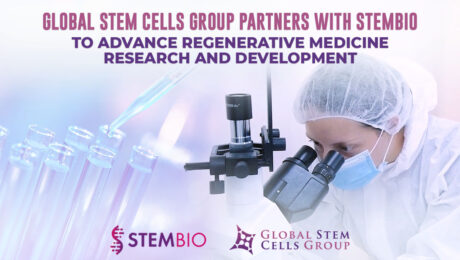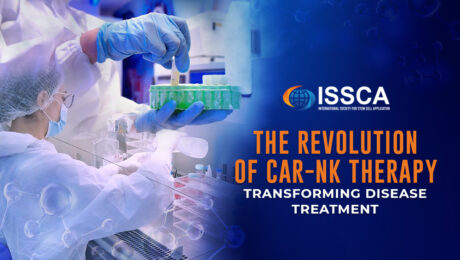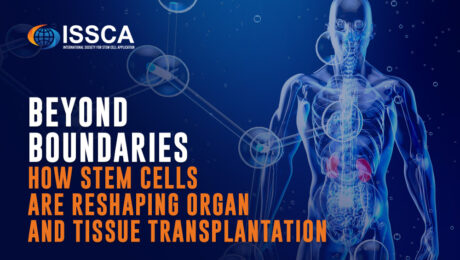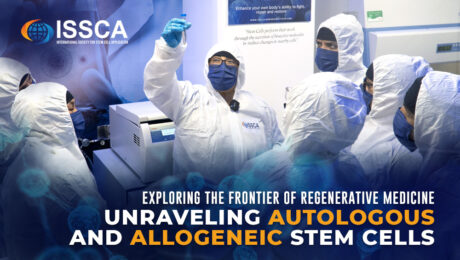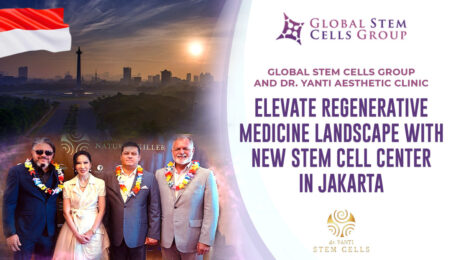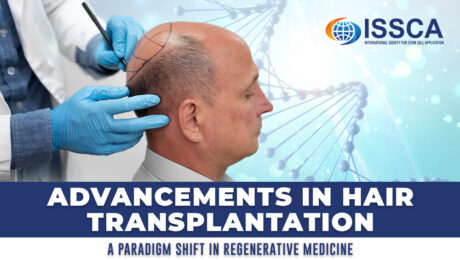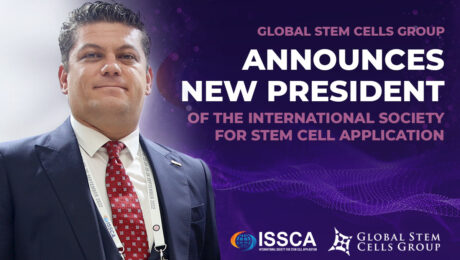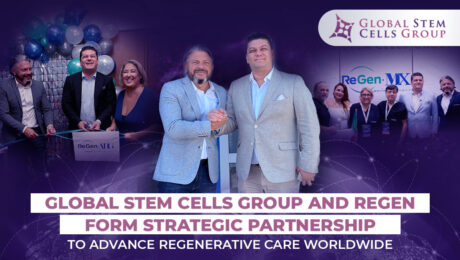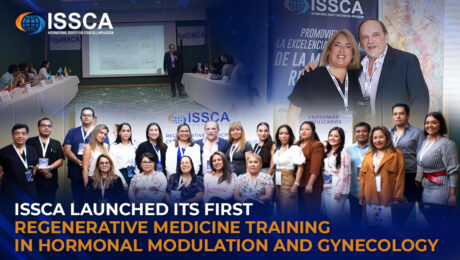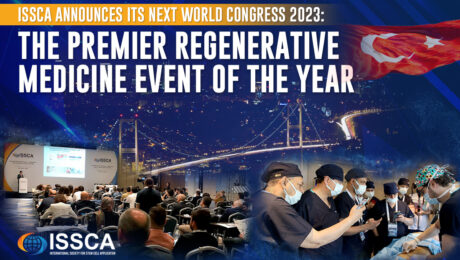Global Stem Cells Group Partners with StemBio to Advance Regenerative Medicine Research and Development
Miami, Florida— Global Stem Cells Group, a leader in regenerative medicine, is thrilled to announce a strategic partnership with StemBio, a renowned leader in the regenerative medicine landscape in Turkey. This partnership aims to propel research and development, conduct clinical trials, and create new products and protocols for the advancement of regenerative medicine.
StemBio, a trailblazer in Turkey, possesses all the necessary licenses and state-of-the-art infrastructure for regenerative medicine, including Bone Marrow Derived MSC, Adipose Derived MSC, Umbilical cord, placenta, Wharton jelly Derived MSC, Synovial Derived MSC, and more. We believe this diverse range of resources demonstrates StemBio’s commitment to excellence, making them one of the foremost facilities for regenerative medicine in Turkey.
This collaboration brings together two powerhouses in the regenerative medicine arena, aiming to break new ground in the research, development, and application of regenerative therapies. We believe the collective expertise and resources of StemBio and Global Stem Cells Group are set to drive innovation and advancements in regenerative care, benefiting patients worldwide.
“We are excited to partner with StemBio and leverage their expertise in regenerative medicine. This partnership should accelerate our mission to provide cutting-edge regenerative solutions to a global audience,” said Benito Novas, head of relationships at Global Stem Cells Group.
We believe the partnership between StemBio and Global Stem Cells Group signifies a significant milestone in the regenerative medicine field. As they combine their strengths and knowledge, they are committed to pushing the boundaries of what is possible in regenerative care and making a lasting impact on patients’ lives.
About Global Stem Cells Group:
The Global Stem Cell Group is a family of several companies focused on stem cell medicine and research. The company uses its network to bring leadership in regenerative medicine training, research, and patient applications.
GSCG’s mission is to allow physicians to present the benefits of stem cell medicine to patients worldwide. The company also partners with policymakers, educators, and regulators to promote regenerative medicine.
Global Stem Cells Group is a publicly traded company operating under the symbol MSSV. https://finance.yahoo.com/quote/mssv/
To learn more about Global Stem Cells Group, Inc.’s companies visit our website www.stemcellsgroup.com or call +1 305 560 5331
About StemBio:
StemBio is a renowned regenerative medicine facility in Turkey, equipped with cutting-edge infrastructure and a commitment to excellence. Holding the necessary licenses for cord blood and tissue banking, as well as advanced engineering solutions, StemBio is a leader in the regenerative medicine landscape.
Safe Harbor Statement: Statements in this news release may be “forward-looking statements”. Forward-looking statements include, but are not limited to, statements that express our intentions, beliefs, expectations, strategies, predictions, or any other information relating to our future activities or other future events or conditions. These statements are based on current expectations, estimates, and projections about our business based partly on assumptions made by management. These statements are not guarantees of future performance and involve risks, uncertainties, and assumptions that are difficult to predict. Therefore, actual outcomes and results may and are likely to differ materially from what is expressed or forecasted in forward-looking statements due to numerous factors. Any forward-looking statements speak only as of the date of this news release, and The Global Stem Cells Group undertakes no obligation to update any forward-looking statement to reflect events or circumstances after the date of this news release. This press release does not constitute a public offer of any securities for sale. Any securities offered privately will not be or have not been registered under the Act and may not be offered or sold in the United States absent registration or an applicable exemption from registration requirements.
- Published in News
The Revolution of CAR-NK Therapy: Transforming Disease Treatment
In the ever-evolving landscape of medical innovation, one breakthrough stands out—a transformative approach known as CAR-NK therapy. This groundbreaking development has the potential to revolutionize disease treatment, offering a safer and more effective solution for patients. Join us as we delve into the five pivotal aspects of CAR-NK therapy, reshaping the future of medical care.

CAR-NK Therapy: Why is it a Game-Changer in Disease Treatment
1. Enhanced Safety and Versatility:
At its core, CAR-NK therapy represents a monumental shift in the treatment of various medical conditions. What sets it apart is its enhanced safety and versatility. Unlike its predecessor, CAR-T therapy, which uses the patient’s own T cells, CAR-NK cells can be derived from healthy donors or stem cells. This distinction significantly reduces the risk of complications, including graft-versus-host disease and cytokine release syndrome, which can sometimes accompany CAR-T therapy. Moreover, CAR-NK cells can be stored and used off-the-shelf, making them more readily available for patients in need.
2. Effective Against a Wide Range of Diseases:
The versatility of CAR-NK therapy extends to its effectiveness against a diverse spectrum of diseases. These remarkable cells possess the ability to target multiple antigens present on various cell types. From hematologic conditions to solid tumors, CAR-NK therapy demonstrates remarkable efficacy. Furthermore, it has the potential to counteract the mechanisms employed by cells to evade the immune system, such as immunosuppression and antigen loss.
3. Cost-Efficiency and Speedy Production:
Another compelling aspect of CAR-NK therapy is its cost-efficiency and rapid production. In comparison to the complex and personalized approach required for CAR-T therapy, CAR-NK cells can be manufactured on a larger scale. This streamlined production process significantly lowers costs, making this innovative therapy more accessible to a wider range of patients. The affordability of CAR-NK therapy brings us one step closer to a future where cutting-edge treatments are within reach for all.
4. A Thriving Field with Promising Potential:
While CAR-NK therapy is still in its early stages of clinical development, the initial results are promising and encouraging. Researchers and medical professionals worldwide are working tirelessly to unlock its full potential. Early trials have demonstrated its safety and efficacy, raising hopes for further breakthroughs in disease treatment.
CAR-NK therapy represents a monumental leap forward in disease treatment. At ISSCA.com, we are dedicated to advancing knowledge in the realm of regenerative medicine. We invite you to explore the transformative possibilities of CAR-NK therapy and its potential to reshape the future of medical care. As we journey together, you’ll discover that the horizon of possibilities in healthcare is continually expanding.
Explore our courses and international congresses at ISSCA.com to deepen your knowledge in regenerative medicine.
- Published in Blog
Beyond Boundaries: How Stem Cells Are Reshaping Organ and Tissue Transplantation
Stem Cells: Pioneers of Regeneration
Within the sacred corridors of medical advancement, a profound transformation is silently taking place, poised to reshape the very foundations of organ and tissue transplantation. Envision a realm where donor shortages and the specter of immune system rejection fade into history, and where medical horizons stretch to unprecedented frontiers. In this immersive voyage, we embark on a journey to unmask the enigmatic power of stem cells in the realm of transplantation, a journey that invites you to witness the precipice of medical progress.
The Choreography of Compatibility
Navigating the intricate choreography of compatibility between donor and recipient is one of the most formidable tasks in transplantation. The ever-watchful immune system often triggers rejection, undermining even the most meticulous transplantation endeavors. Yet, stem cells are orchestrating a symphony of change. Through ingenious techniques, researchers are tapping into stem cells’ immunomodulatory prowess, crafting an environment of harmonious coexistence between donor and recipient. This revolutionary approach not only mitigates the risks of rejection but also broadens the spectrum of viable donors.
A Symphony of Science
The harmony between stem cells and transplantation is not an untested hypothesis; it’s a symphony composed through rigorous scientific exploration. An extensive repertoire of peer-reviewed studies, gracing the pages of prestigious journals such as The Lancet and Nature Communications, underscores the potential of stem cells to elevate transplant success rates. These studies illuminate advancements spanning from refining graft survival to hastening the regeneration of vital tissues, a resounding affirmation of the transformative capabilities underpinning stem cell-driven transplantation.
Embark on a Journey of Revelation
Eager to unravel the mysteries encapsulating stem cell-powered transplantation? We extend a heartfelt invitation to embark on an illuminating expedition through our comprehensive training courses in regenerative medicine. Enrich your understanding under the tutelage of eminent experts, delving into the most recent breakthroughs, evidence-based methodologies, and clinical applications. Step into a realm where the boundaries of medical possibilities are redrawn, where your perception of transplantation is enriched, and where you assume the mantle of a pioneer in the regenerative revolution.
The fusion of stem cells and organ transplantation isn’t confined to the realm of scientific speculation; it represents a monumental stride towards re-scripting the destinies of countless lives. As we venture into an epoch where medical accomplishments redefine our limits, the expedition becomes all the more exhilarating.
Join us at issca.us, where the convergence of science and hope awaits. Immerse yourself in the vanguard of regenerative medicine, where the transformative prowess of stem cells beckons. Together, we shall forge ahead, empowered by the symphony of possibilities, shaping a brighter, healthier future for generations to come.
- Published in Blog
Exploring the Frontier of Regenerative Medicine: Unraveling Autologous and Allogeneic Stem Cells
WEDNESDAY, 06 SEPTEMBER 2023 / PUBLISHED IN BLOG
Exploring the Frontier of Regenerative Medicine: Unraveling Autologous and Allogeneic Stem Cells
In the realm of modern medicine, a groundbreaking field has emerged, promising to reshape the way we approach healing and rejuvenation – regenerative medicine. At the heart of this revolution lie stem cells, the unsung heroes of tissue repair and regeneration. In this comprehensive exploration, we delve into the intricate differences between two crucial types of stem cells: autologous and allogeneic. Prepare to be captivated by the scientific intricacies that underpin these extraordinary cells and discover how they’re poised to redefine medical possibilities.
Autologous Stem Cells: A Personalized Touch
Imagine harnessing the power of your body’s own natural healing abilities. Autologous stem cells make this vision a reality. Derived from your own tissues – be it bone marrow, adipose tissue, or other sources – these cells hold the promise of personalized healing. The process involves harvesting the stem cells, processing them to enhance their therapeutic potential, and then reintroducing them into the body. This “self-healing” approach minimizes the risk of rejection and side effects, making autologous stem cell therapies an attractive option for many.
Scientific Precision
Autologous stem cell therapies are supported by a wealth of scientific evidence. Studies published in esteemed journals like the Journal of Translational Medicine and Stem Cell Research & Therapy have highlighted their potential in diverse applications, from musculoskeletal disorders to cardiovascular conditions. This approach holds immense promise for targeted healing while minimizing the risk of immune system complications.
Allogeneic Stem Cells: A Shared Resource for Healing
In the quest for regenerative solutions, allogeneic stem cells emerge as a game-changer. These cells are sourced from carefully screened donors and subsequently administered to patients. By tapping into a shared pool of stem cells, medical practitioners can provide a standardized treatment option that’s readily available. Allogeneic stem cells hold the potential to address a broad spectrum of conditions, offering a versatile and accessible avenue for regenerative therapies.
Scientific Validation
The science behind allogeneic stem cell therapies is compelling. Rigorous research published in renowned journals such as the Journal of Stem Cells and Development and Stem Cells Translational Medicine has underscored their efficacy in various medical scenarios. This approach not only broadens the scope of treatment but also expedites the therapeutic process, presenting an exciting frontier in regenerative medicine.
Embrace the Future with Knowledge
Intrigued by the dynamic interplay of autologous and allogeneic stem cells in regenerative medicine? We invite you to embark on a transformative journey of discovery through our comprehensive training courses. Our platform offers unparalleled insights into the latest advancements, evidence-based practices, and clinical applications of these remarkable stem cells. Guided by esteemed experts in the field, our courses provide a unique opportunity to stay at the forefront of regenerative medicine’s evolution.
As the horizon of medicine expands to encompass regenerative possibilities, autologous and allogeneic stem cells take center stage. These cellular protagonists hold the key to unlocking personalized healing and broad-spectrum rejuvenation, ushering in an era of medical advancement like never before. Join us in our mission to unravel the mysteries of regenerative medicine and explore the profound potential of stem cells. Visit issca.us today, and together, let’s embark on a journey that could reshape the landscape of healthcare for generations to come.
- Published in Blog
Global Stem Cells Group (GSCG) and Dr. Yanti Aesthetic Clinic Elevate Regenerative Medicine Landscape with New Stem Cell Center in Jakarta
Miami, Florida – Global Stem Cells Group (GSCG) is thrilled to announce the grand opening of its latest state-of-the-art Stem Cell Center, located in Jakarta, Indonesia. This momentous occasion marks a significant stride forward in the field of regenerative medicine and showcases GSCG’s commitment to providing innovative healthcare solutions worldwide.
In a groundbreaking partnership with the esteemed Dr. Yanti Aesthetic Clinic, GSCG introduces its third Stem Cell Center in Indonesia, complementing existing facilities in Surabaya and Bandung. Further underscoring their dedication to advancing medical research, GSCG also anticipates the unveiling of a fourth location in Bali in the near future.
The launch of the Stem Cell Center in Jakarta serves as a beacon of innovation, the International Society for Stem Cell Application (ISSCA), GSCG’s educational division, conducted a groundbreaking training session alongside Dr. Alan Gaveck. This session spotlighted the transformational potential of NK cell therapies in treating Cancer and Anti-aging concerns, further cementing GSCG’s pioneering influence.
A distinctive feature of this collaboration is the authorization granted to Dr. Yanti Aesthetic Clinic to leverage GSCG’s brand, technologies, products, and treatment protocols. Operating as a franchise, the center proudly carries the brand, adhering to meticulous organizational guidelines, while being owned and operated by Dr. Yanti Aesthetic Clinic. This symbiotic arrangement seamlessly merges shared expertise with individual ownership, fostering a harmonious blend of vision and innovation.
Beyond its role as a clinical hub, the newly inaugurated Stem Cell Center will also serve as a focal point for ISSCA’s training initiatives in Asia. In addition to the pioneering NK cell therapy training conducted at the clinic, the center will facilitate educational programs to empower medical professionals across the continent with cutting-edge insights and advancements in regenerative medicine.
Benito Novas, an esteemed figure in the realm of regenerative medicine and the head of Public Relations for GSCG and ISSCA, shared his insights during the inaugural event, stating, “Global Stem Cells Group is dedicated to democratizing regenerative medicine access on a global scale. We encourage physicians to embrace the clinical and aesthetic applications of stem cell therapy, enabling patients around the world to experience the transformative benefits of regenerative treatments.”
Reflecting on the journey that led to this momentous occasion, Novas continued, “Dr. Yanti and I met in Brussels back in 2018, when this ambitious endeavor was but a vision. Today, as we witness the fruition of that vision, I express my profound gratitude for the privilege of collaborating with Dr. Yanti Aesthetic Clinic in ushering in the future of regenerative medicine.”
Dr. Yanti Kushmiran, Director of the DR. Yanti Aesthetic Clinic, echoed these sentiments, stating, “Our partnership with GSCG, a trailblazer with over a decade of pioneering work, resonates deeply with our commitment to excellence. The establishment of our third Stem Cell Center in Indonesia under the esteemed Global Stem Cells Group brand strengthens our ability to provide enhanced services to our patients, ushering in a new era of regenerative healthcare.”
With the inauguration of the Stem Cell Center in Jakarta, GSCG and Dr. Yanti Aesthetic Clinic take a significant stride towards advancing regenerative medicine’s frontiers. This landmark collaboration is poised to shape the future of medical care, leveraging cutting-edge technologies and expertise to benefit patients across the Asian continent and beyond.
About Dr. Yanti Aesthetic Clinic:
Dr. Yanti Aesthetic Clinic is a revered healthcare institution renowned for its state-of-the-art aesthetic and regenerative treatments. With an unwavering dedication to excellence and a forward-thinking approach, Dr. Yanti Aesthetic Clinic is poised to shape the future of regenerative medicine in Indonesia and beyond.
About the International Society for Stem Cell Application (ISSCA):
The International Society for Stem Cell Application (ISSCA) serves as the educational arm of Global Stem Cells Group (GSCG), dedicated to promoting knowledge and expertise in stem cell therapy and regenerative medicine. ISSCA empowers medical professionals across the globe with essential insights and advancements in the field.
About Global Stem Cell Group
The Global Stem Cell Group is a family of several companies focused on stem cell medicine and research. The company uses its network to bring leadership in regenerative medicine training, research, and patient applications.
GSCG’s mission is to allow physicians to present the benefits of stem cell medicine to patients worldwide. The company also partners with policymakers, educators, and regulators to promote regenerative medicine.
Global Stem Cells Group is a publicly traded company operating under the symbol MSSV. https://finance.yahoo.com/quote/mssv/
To learn more about Global Stem Cells Group, Inc.’s companies visit our website www.stemcellsgroup.com or call +1 305 560 5331
Safe Harbor Statement: Statements in this news release may be “forward-looking statements”. Forward-looking statements include, but are not limited to, statements that express our intentions, beliefs, expectations, strategies, predictions, or any other information relating to our future activities or other future events or conditions. These statements are based on current expectations, estimates, and projections about our business based partly on assumptions made by management. These statements are not guarantees of future performance and involve risks, uncertainties, and assumptions that are difficult to predict. Therefore, actual outcomes and results may and are likely to differ materially from what is expressed or forecasted in forward-looking statements due to numerous factors. Any forward-looking statements speak only as of the date of this news release, and The Global Stem Cells Group undertakes no obligation to update any forward-looking statement to reflect events or circumstances after the date of this news release. This press release does not constitute a public offer of any securities for sale. Any securities offered privately will not be or have not been registered under the Act and may not be offered or sold in the United States absent registration or an applicable exemption from registration requirements.
- Published in News
Advancements in Hair Transplantation: A Paradigm Shift in Regenerative Medicine
WEDNESDAY, 09 AUGUST 2023 / PUBLISHED IN BLOG
In the realm of regenerative medicine, hair transplantation has experienced remarkable progress in recent years. As part of a multidisciplinary community of physicians and scientists dedicated to advancing the field, it is essential to stay informed about the latest developments in this area. This blog post aims to provide a comprehensive overview of the cutting-edge advancements in hair transplantation, highlighting the convergence of science, technology, and practice.
Tissue Engineering in Hair Transplantation
The integration of tissue engineering principles into hair transplantation has opened new avenues for regenerative medicine. Scientists are actively exploring the use of biomaterials, growth factors, and scaffolds to create an optimal environment for transplanted hair follicles. By nurturing follicular cells, tissue engineering techniques hold immense potential in enhancing transplantation outcomes and promoting tissue regeneration.
Stem Cell-Based Approaches
Stem cell therapy has emerged as a promising strategy within the realm of hair transplantation. Researchers are investigating the utilization of mesenchymal stem cells (MSCs) and adipose-derived stem cells (ADSCs) to stimulate hair follicle regeneration. These unique regenerative cells promote hair growth and significantly enhance the success rate of transplantation procedures. Ongoing research in stem cell-based therapies continues to unveil their potential to revolutionize hair restoration techniques.
Gene Therapy for Hair Loss
Gene therapy is gaining traction as a cutting-edge approach to addressing hair loss at its core. Scientists aim to develop innovative treatments for both genetic and acquired forms of hair loss by manipulating genes involved in hair growth and regulation. Techniques such as CRISPR-Cas9 gene editing hold immense potential for altering gene expression associated with hair follicle development, offering personalized regenerative therapies.
Nanotechnology in Hair Transplantation
Nanotechnology has paved the way for groundbreaking advancements in hair transplantation. Researchers are exploring the application of nanomaterials and nanoparticles to enhance the targeted delivery of growth factors, drugs, and stem cells directly to the hair follicles. This precise and controlled release optimizes the regenerative potential of transplanted hair follicles, leading to improved treatment outcomes and faster healing.
Artificial Intelligence (AI) and Machine Learning
The integration of AI and machine learning algorithms has transformed various medical fields, including hair transplantation. AI-powered technologies assist in precise hair follicle extraction, optimizing graft placement, and predicting post-transplant outcomes. By analyzing vast datasets and patterns, AI algorithms enhance decision-making, improve surgical techniques, and contribute to personalized treatment plans in hair transplantation.
As active contributors to the advancement of regenerative medicine, staying informed about the latest developments in hair transplantation is crucial. Tissue engineering, stem cell-based approaches, gene therapy, nanotechnology, and the integration of AI and machine learning are reshaping the landscape of hair restoration. By remaining at the forefront of these advancements, physicians and scientists can harness the power of regenerative medicine to effectively treat hair loss and alleviate human suffering.
Join us at issca.us and let us continue to collaborate, innovate, and explore the limitless potential of regenerative therapies.
- Published in Blog
Global Stem Cells Group Announces New President of the International Society for Stem Cell Application (ISSCA)
Miami, Florida – Global Stem Cells Group, a leading organization in the field of regenerative medicine, is pleased to announce the appointment of Dr. Salih Yildirim as the new President of the International Society for Stem Cell Application (ISSCA), a division of Global Stem Cells Group. Dr. Yildirim previously held the position of Director of Overseas Operations at ISSCA.
Dr. Salih Yildirim brings a wealth of experience and expertise to his new role as President of ISSCA. Having previously served as the Director of Overseas Operations, Dr. Yildirim has demonstrated his exceptional leadership skills and strategic vision throughout his career. He has played a vital role in expanding ISSCA’s international presence and fostering collaborations with stakeholders worldwide.
In a statement regarding the appointment, Dr. Daeyong Kim, the former President of ISSCA, expressed his confidence in Dr. Yildirim’s ability to lead the organization. Dr. Kim stated, “I think you are the best leader and the most prepared to be the President of ISSCA. Therefore, I think you should be the head of ISSCA.” Dr. Kim will now transition to other support functions within ISSCA.
Benito Novas, head of Public Relations for ISSCA, expressed his admiration for Dr. Salih Yildirim’s professional qualities. Novas said, “I have known and worked with Dr. Salih for more than 10 years, and I am honored to have him as President within the company. During these years, he has proven to be an exceptional leader with a great vision for ISSCA.”
ISSCA’s objectives under the leadership of Dr. Salih Yildirim will include advancing the understanding and application of stem cell therapies, promoting scientific research and collaboration among professionals in the field, and advocating for the ethical and responsible use of regenerative medicine worldwide. Dr. Yildirim’s extensive experience in business development, international relations, and regenerative medicine will undoubtedly contribute to the achievement of these objectives.
About Dr. Salih Yildirim:
Dr. Salih Yildirim holds a bachelor’s and master’s degrees in business administration from Cleveland State University (United States) and a Ph.D. in health management from the University of Health Sciences. He has held various key positions throughout his career, including Director of Overseas Operations at ISSCA. Dr. Yildirim is currently the General Manager of BioTrend Medical International, a biotechnology firm specializing in genetics, molecular biology, and stem cell technologies. He also serves as the chief executive officer of ReGen.IC Clinic, specializing in regenerative medicine and stem cell applications. Additionally, he is a member of the International Society for Stem Cell Application’s Board of Directors and the Global Stem Cell Group’s Board of Directors and International Operations Manager. Dr. Yildirim is also a member of Istanbul Atlas University’s Board of Directors. He is married and a proud father.
About ISSCA
The International Society for Stem Cell Application (ISSCA) is a multidisciplinary community of scientists and physicians who aspire to treat diseases and lessen human suffering through advances in science, technology, and regenerative medicine.
ISSCA updates its members on advances in stem cell research, MSC, exosomes, and regenerative medicine
The ISSCA’s vision is to take a leadership position in promoting excellence and setting standards in the regenerative medicine fields of publication, research, education, training, and certification.
The international community provides a platform for practitioners to interact with scientists and build medical networks necessary for marketing.
As a medical specialty, regenerative medicine standards and certifications are essential, which is why ISSCA offers certification training in cities worldwide. The goal is to encourage more physicians to practice regenerative medicine and make it available to patients nationally and internationally. Incorporated under the Republic of Korea as a non-profit company, the ISSCA is focused on fostering excellence and standards in regenerative medicine.
About Global Stem Cells Group
Global Stem Cells Group is the parent company of six companies that are dedicated to stem cell research, solutions, and technology training. The group was founded in 2012 and combines dedicated researchers, patient educators, and physician trainers with the shared goal of meeting the need for high-end stem cell solutions and treatments.
Given that the group has a singular focus in this field, it is uniquely positioned to become the global leader in cellular medicine. In addition, by bringing together leading professionals in cellular medicine, it can discover issues that the industry faces and focus its research and development in this area. This specialization has, undoubtedly, enabled it to come up with solutions that address some of the significant issues that most stakeholders are facing in the industry.
Global Stem Cells Group is a publicly traded company operating under the symbol MSSV. https://finance.yahoo.com/quote/mssv/
Safe Harbor Statement: Statements in this news release may be “forward-looking statements”. Forward-looking statements include, but are not limited to, statements that express our intentions, beliefs, expectations, strategies, predictions, or any other information relating to our future activities or other future events or conditions. These statements are based on current expectations, estimates, and projections about our business based partly on assumptions made by management. These statements are not guarantees of future performance and involve risks, uncertainties, and assumptions that are difficult to predict. Therefore, actual outcomes and results may and are likely to differ materially from what is expressed or forecasted in forward-looking statements due to numerous factors. Any forward-looking statements speak only as of the date of this news release, and The Global Stem Cells Group undertakes no obligation to update any forward-looking statement to reflect events or circumstances after the date of this news release. This press release does not constitute a public offer of any securities for sale. Any securities offered privately will not be or have not been registered under the Act and may not be offered or sold in the United States absent registration or an applicable exemption from registration requirements.
- Published in News
Global Stem Cells Group and ReGen Form Strategic Partnership to Advance Regenerative Care Worldwide
Global Stem Cells Group, a leader in the field of regenerative medicine, proudly announces an innovative partnership with ReGen, a highly acclaimed Turkish clinic renowned for its cutting-edge technologies in aesthetic and regenerative care. This strategic alliance exemplifies Global Stem Cells Group’s commitment to advancing the field of regenerative medicine and expanding global access to transformative treatments.
As a trailblazer in the industry, Global Stem Cells Group actively seeks strategic partnerships with companies and organizations that share its vision of advancing regenerative care. The collaboration with ReGen signifies a remarkable milestone in this endeavor.
A Solid Partnership
ReGen, a highly regarded clinic specializing in advanced regenerative care technologies, has joined forces with Global Stem Cells Group to facilitate the expansion of franchising opportunities for specialized regenerative care clinics worldwide. By harnessing the collective strengths of both organizations, this partnership aims to cultivate an environment where their shared expertise and services can flourish, delivering regenerative healthcare solutions to individuals across the globe.
Rapid Growth
Through the partnership, ReGen has experienced remarkable growth, leveraging the Global Stem Cells Group’s name and resources to open two state-of-the-art clinics in Buenos Aires, Argentina, and Cancun, Mexico. These clinics have established themselves as pioneers in the field of regenerative care, surpassing existing alternatives in the region.
By introducing cutting-edge aesthetic treatments such as the perfected hair transplant technique from Turkey, ReGen is revolutionizing the landscape of regenerative healthcare. The clinics now offer patients access to the latest and most effective treatment options available. ReGen’s ability to bring their expertise to new regions underscores Global Stem Cells Group’s vision of making their exceptional services accessible to individuals worldwide.
The Trained Expert Behind ReGen
Leading the way at ReGen is Dr. Salih Yildirim, an esteemed CEO with a visionary mindset committed to spearheading a paradigm shift in the realm of regenerative medicine. Driven by an unwavering passion to extend the benefits of cutting-edge aesthetic technologies hailing from Turkey, encompassing areas such as hair transplantation, rhinoplasty, mammoplasty, and stem cell treatments, he has taken the momentous decision to expand the global presence of ReGen clinics. This strategic alliance with the esteemed Global Stem Cells Group aims to grant greater accessibility to Turkey’s esteemed aesthetic and regenerative medicine treatments, catering to a broader spectrum of patients.
Evident in this initiative is ReGen’s resolute dedication to disseminate its advanced techniques and state-of-the-art technologies across the globe, thereby propelling progress in the field of regenerative medicine.
How Global Stem Cells Group Can Improve ReGen’s Reach
While ReGen brings its advanced techniques and expertise to the partnership, Global Stem Cells Group offers a range of valuable resources. As a conglomerate of companies engaged in product manufacturing and comprehensive training through the International Society for Stem Cell Application (ISSCA), Global Stem Cells Group enhances the partnership’s outreach and impact. This collaboration has the potential to be life-changing for individuals seeking regenerative care worldwide.
Dr. Yildirim expresses his satisfaction with the partnership, stating, “We are delighted to join forces with Global Stem Cells Group. This collaboration allows us to establish additional points of care globally, furthering the accessibility of stem cell applications and advancing regenerative medicine.”
This milestone partnership between Global Stem Cells Group and ReGen is destined to reshape the world of regenerative care. It represents a turning point that will be remembered as a transformative moment for the field of regenerative medicine.
Benito Novas, CEO of Global Stem Cells Group, emphasizes the significance of this alliance, stating, “Our collaboration with Dr. Yildirim spans several years, and he has consistently demonstrated exceptional leadership and humility. By incorporating the ReGen program into the Global Stem Cells Group umbrella, which encompasses products manufacturing, ISSCA training, and centers of excellence for point-of-care regenerative medicine, we continue to solidify our commitment to excellence.”
As this partnership evolves, both organizations will continue to work tirelessly to develop new treatments, enhance existing procedures, and ensure the highest standards of patient care. Through their joint efforts, they will accelerate the adoption of regenerative care practices on a global scale, creating a ripple effect that will benefit patients and healthcare providers alike.
For more information about Global Stem Cells Group and its regenerative medicine solutions, please visit https://www.stemcellsgroup.com/.
About Global Stem Cells Group
Global Stem Cells Group is a leading provider of regenerative medicine solutions, dedicated to advancing healthcare through innovative therapies. With a global presence and a multidisciplinary team of experts, the organization strives to harness the potential of stem cells and regenerative medicine to improve patient outcomes across various medical fields. Through its extensive network of clinics, research facilities, and training centers, Global Stem Cells Group is committed to pushing the boundaries of regenerative medicine and making a positive impact on global healthcare.
About ReGen
ReGen is a highly acclaimed Turkish clinic renowned for its expertise in cutting-edge technologies related to regenerative care. Headquartered in Istanbul, ReGen has gained international recognition for its commitment to excellence and its groundbreaking advancements in regenerative medicine. By partnering with Global Stem Cells Group, ReGen aims to share its advanced techniques and expertise on a global scale, improving access to regenerative care and transforming lives worldwide.
Safe Harbor Statement: Statements in this news release may be “forward-looking statements”. Forward-looking statements include, but are not limited to, statements that express our intentions, beliefs, expectations, strategies, predictions, or any other information relating to our future activities or other future events or conditions. These statements are based on current expectations, estimates, and projections about our business based partly on assumptions made by management. These statements are not guarantees of future performance and involve risks, uncertainties, and assumptions that are difficult to predict. Therefore, actual outcomes and results may and are likely to differ materially from what is expressed or forecasted in forward-looking statements due to numerous factors. Any forward-looking statements speak only as of the date of this news release, and The Global Stem Cells Group undertakes no obligation to update any forward-looking statement to reflect events or circumstances after the date of this news release. This press release does not constitute a public offer of any securities for sale. Any securities offered privately will not be or have not been registered under the Act and may not be offered or sold in the United States absent registration or an applicable exemption from registration requirements.
- Published in News
ISSCA launched its first regenerative medicine training in Hormonal Modulation and Gynecology
Miami, Florida – The International Society for Stem Cell Application (ISSCA), a division of Global Stem Cells Group (GSCG), successfully launched its inaugural training course in Hormonal Modulation and Gynecology, marking a significant milestone in the field of regenerative medicine. The course, held from June 10-12, 2023, in Cancun, Mexico, generated immense enthusiasm among participants as the Global Stem Cell Group demonstrated its commitment to disseminating cutting-edge training and information to medical professionals worldwide.
Led by a Well-Respected Doctor
Under the guidance of Dr. Jorge Alberto Elias, a renowned Gynecologist and Urogynecologist with over a decade of experience in Cellular Therapies, participants had the privilege of learning from a highly respected expert in the field. His expertise ensured that attendees received valuable and up-to-date information, enhancing the quality of their educational experience.
The event was divided between two esteemed venues, with the theoretical portion taking place at the Four Points Hotel, and the hands-on training conducted at the prestigious Cellular Hope Institute.
ISSCA commitment to advancing regenerative medicine was further demonstrated by the inclusion of over 30 doctors who joined the event remotely, accessing the conferences and the live proceedings through online channels. This approach enabled medical professionals worldwide to be part of the educational experience, even if they couldn’t attend in person. By embracing technology, the company expanded the reach of knowledge dissemination and fostered a global community of practitioners dedicated to staying at the forefront of regenerative medicine.
The training program focused on equipping doctors and medical professionals with the latest advancements in regenerative medicine, with a specific emphasis on gynecology. Participants delved into the cutting-edge techniques and breakthrough procedures that are shaping the field.
Three Days of Intense Learning
The three-day program was divided into theoretical sessions and hands-on practical training. The theoretical portion took place at the Four Points Hotel, where participants delved into the intricacies of hormonal modulation and its application in gynecology. Dr. Silvina Pastrana, director of ISSCA education in Latam, complemented the program with a session on Exosomes, stem cells, and automatic closed processing techniques using the GCell machine, providing a comprehensive overview of the latest advancements.
During the practical segment, participants convened at the Cellular Hope Institute, where they were immersed in real-life scenarios and witnessed the application of regenerative measures in gynecological cases. Seven diverse cases were presented, including Labiaplasty, Perineum Vaginoplasty, Lichen Sclerosus, Liposuction Mount of Venus, and Lipo fat transfer with open and closed techniques. Through these hands-on demonstrations, attendees gained practical skills and insights into utilizing regenerative medicine to enhance patients’ quality of life.
Reflecting on the success of the event, Benito Novas, Head of Public Relations for the International Society for Stem Cell Application, expressed his enthusiasm, stating, “We are delighted to further expand the ISSCA faculty and specialty areas, opening the door for all physicians to utilize the latest Regenerative Medicine technologies in their area of expertise. Our goal is to provide the best education and training in regenerative medicine and cellular therapies so that professionals can offer the highest quality care to their patients.”
ISSCA celebrates the tremendous success of this inaugural regenerative medicine training course and remains committed to expanding access to the latest knowledge and advancements in the field. By empowering medical professionals globally, ISSCA aims to help patients worldwide benefit from the latest strategies and breakthroughs in regenerative medicine.
About ISSCA
The International Society for Stem Cell Application (ISSCA) is a multidisciplinary community of scientists and physicians who aspire to treat diseases and lessen human suffering through advances in science, technology, and regenerative medicine.
ISSCA updates its members on advances in stem cell research, MSC, exosomes, and regenerative medicine
The ISSCA’s vision is to take a leadership position in promoting excellence and setting standards in the regenerative medicine fields of publication, research, education, training, and certification.
The international community provides a platform for practitioners to interact with scientists and build medical networks necessary for marketing.
As a medical specialty, regenerative medicine standards and certifications are essential, which is why ISSCA offers certification training in cities worldwide. The goal is to encourage more physicians to practice regenerative medicine and make it available to patients nationally and internationally. Incorporated under the Republic of Korea as a non-profit company, the ISSCA is focused on fostering excellence and standards in regenerative medicine.
About Global Stem Cells Group
Global Stem Cells Group is the parent company of six companies that are dedicated to stem cell research, solutions, and technology training. The group was founded in 2012 and combines dedicated researchers, patient educators, and physician trainers with the shared goal of meeting the need for high-end stem cell solutions and treatments.
Given that the group has a singular focus in this field, it is uniquely positioned to become the global leader in cellular medicine. In addition, by bringing together leading professionals in cellular medicine, it can discover issues that the industry faces and focus its research and development in this area. This specialization has, undoubtedly, enabled it to come up with solutions that address some of the significant issues that most stakeholders are facing in the industry.
Global Stem Cells Group is a publicly traded company operating under the symbol MSSV. https://finance.yahoo.com/quote/mssv/
Safe Harbor Statement: Statements in this news release may be “forward-looking statements”. Forward-looking statements include, but are not limited to, statements that express our intentions, beliefs, expectations, strategies, predictions, or any other information relating to our future activities or other future events or conditions. These statements are based on current expectations, estimates, and projections about our business based partly on assumptions made by management. These statements are not guarantees of future performance and involve risks, uncertainties, and assumptions that are difficult to predict. Therefore, actual outcomes and results may and are likely to differ materially from what is expressed or forecasted in forward-looking statements due to numerous factors. Any forward-looking statements speak only as of the date of this news release, and The Global Stem Cells Group undertakes no obligation to update any forward-looking statement to reflect events or circumstances after the date of this news release. This press release does not constitute a public offer of any securities for sale. Any securities offered privately will not be or have not been registered under the Act and may not be offered or sold in the United States absent registration or an applicable exemption from registration requirements.
- Published in News
ISSCA Announces Its Next World Congress 2023: The Premier Regenerative Medicine Event of the Year
The International Society for Stem Cell Application (ISSCA) is excited to announce the much-anticipated World Congress 2023, further establishing its role as the primary global hub for regenerative medicine. The event is set to occur from November 10 to 12, 2023, at the esteemed Crowne Plaza Istanbul Florya Hotel in Istanbul, Turkey. Drawing on the remarkable achievements of the previous conference held at the Radisson Blu Hotel on September 23 to 26, 2022, ISSCA is prepared to exceed all predictions with this highly anticipated World Congress.
During the three-day congress, prominent physicians from across the globe will come together, offering an extensive agenda of presentations and interactive sessions. “Our ISSCA Congresses once more provide a great opportunity to disseminate this information to the physicians who need it most, and we plan to organize as many as we can before the end of the year,” says ISSCA Managing Director and CEO of Global Stem Cells Group Benito Novas about the upcoming congress.
Participants can anticipate captivating workshops, including those focused on aesthetic and clinical applications, aimed at delving into the most recent advancements within the rapidly evolving field of regenerative medicine.
In a full schedule of lectures, the congress will shed light on significant subjects such as molecular biology, innovative treatment approaches in surgical and cosmetic domains, and the latest cutting-edge technologies that have emerged in the field. In addition, the congress will explore the legal framework encompassing regenerative medicine practices on a global scale, acknowledging the varying degrees of involvement by various national governments.
This conference demonstrates ISSCA’s dedication to facilitating a transformative change from traditional healthcare methods to regenerative medicine while showcasing the most recent innovative discoveries and progress in all aspects of stem cell research.
The Crowne Plaza Istanbul Florya Hotel, known for its modern facilities and ideal location in Istanbul, Turkey, will serve as the prestigious venue for this highly anticipated event. Its comfortable and conducive environment provides the optimum platform for attendees to exchange ideas and establish new partnerships.
The ISSCA World Congress 2023 in Istanbul is a must-attend event for anyone interested in regenerative medicine. With a focus on innovation, collaboration, and knowledge exchange, the congress promises to be a transformative experience for all attendees. Whether you are a scientist, physician, or healthcare professional, this event offers an opportunity to gain valuable insights and forge new connections with like-minded individuals from around the world.
For more information about the November 10 to 12 ISSCA World Congress 2023, please visit our official website today.
About ISSCA:
The International Society for Stem Cell Application (ISSCA) is a multidisciplinary community of scientists and physicians who aspire to treat diseases and lessen human suffering through advances in science, technology, and the practice of regenerative medicine. ISSCA serves its members through advancements made in the specialty of regenerative medicine.
The mission of the International Stem Cell Certification Agency (ISSCA) is to establish itself as a global leader in regenerative medicine certification, education, research, and training.
ISSCA provides certification training in cities worldwide because it recognizes the importance of standards and certifications in regenerative medicine as a medical specialty. To help more people, both locally and globally, as the demand for more doctors interested in and comfortable with regenerative medicine surges. ISSCA’s mission is to advance quality and uniformity in regenerative medicine worldwide.
About Global Stem Cells Group:
The Global Stem Cell Group is a family of several companies focused on stem cell medicine and research. The company uses its network to bring leadership in regenerative medicine training, research, and patient applications.
GSCG’s mission is to allow physicians to present the benefits of stem cell medicine to patients worldwide. The company also partners with policymakers, educators, and regulators to promote regenerative medicine.
Global Stem Cells Group is a publicly traded company operating under the symbol MSSV. https://finance.yahoo.com/quote/mssv/
To learn more about Global Stem Cells Group, Inc.’s companies visit our website www.stemcellsgroup.com or call +1 305 560 5331
Safe Harbor Statement:
Statements in this news release may be “forward-looking statements”. Forward-looking statements include, but are not limited to, statements that express our intentions, beliefs, expectations, strategies, predictions, or any other information relating to our future activities or other future events or conditions. These statements are based on current expectations, estimates, and projections about our business based partly on assumptions made by management. These statements are not guarantees of future performance and involve risks, uncertainties, and assumptions that are difficult to predict. Therefore, actual outcomes and results may and are likely to differ materially from what is expressed or forecasted in forward-looking statements due to numerous factors. Any forward-looking statements speak only as of the date of this news release, and The Global Stem Cells Group undertakes no obligation to update any forward-looking statement to reflect events or circumstances after the date of this news release. This press release does not constitute a public offer of any securities for sale. Any securities offered privately will not be or have not been registered under the Act and may not be offered or sold in the United States absent registration or an applicable exemption from registration requirements.
- Published in News


